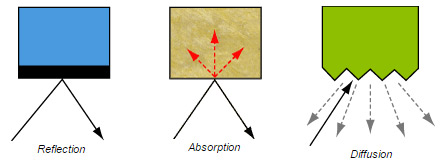
Sound is such a big part of our lives that we often don’t think too much about it.
When it comes down to it, sound is pretty complex. Depending on the type of space that a noise is in, it will behave in different ways.
Sound In An Enclosed Space
When sound is released into an enclosed space, it will behave based on the material of the walls. Typically, there are two types of materials; those that allow acoustic waves to pass through, and those that don’t.
If the materials of these barriers do not allow sound to pass through, the sound wave will either:
- Reflect
- Diffuse
- Echo
Generally, these things do not bode well in the way of good acoustics. However, if the sound is diffused evenly, it generally improves the acoustics of the room and increases speech intelligibility.
Alternatively, if the material does allow for these waves to pass through, it will absorb.

Image: www.primacoustic.com
What absorption does for your acoustics depends on the extent of sound that is allowed to pass through, as some sounds may still reflect.
Check out our previous blog on Room Acoustics: The Most Popular Topics for a more in depth rundown on some of these sound behaviours.
Which One Makes For Good Acoustics?
Typically, for good room acoustics you will want to have more materials absorbing and evenly diffusing noise, than those that reflect it and cause echoing.
If you aren’t sure of the problem areas of your space, a professional Acoustic Appraisal can determine your Reverberation Time and locate the issues in your room.
At Nomadtika, we also offer a Product Recommendation service. Our expert team will suggest the best acoustic and decorative products to improve your space, in a style that suits you. Have a look at our wide range of acoustic products here.
For all your acoustic needs, contact the team at Nomadtika today!

